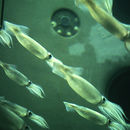Diagnostic Description
provided by FAO species catalogs
Mantle robust, widest at midpoint between anterior end and beginning of fins; tail not sharply pointed. Fin angle moderate, 40° to 50° mostly 45° ; fin width greater than fin length. Head small, short and narrow. Arms relatively short, of about equal length in both sexes; hectocotylized arm (in males) shorter than the opposite ventral arm (IV), its modified portion very short, about 22% of arm length; trabeculae (lamellae) without papillose fringed flaps; 1 or 2 knobs on dorsal row of lamellae on modified arm tip. Colour: reddish-brown to deep purple, more intense on head, arms and dorsal surface of mantle and fins; paler on ventral surfaces; a brilliant yellowish-green tint.
- 'Dor, Durward & Balch (1977, maintenance in tanks)
- Amaratunga, (1980, growth)
- Clarke (1966, biology)
- Durward et al. (1980, reproduction)
- Lange & Sissenwine (in press, resources)
- Mesnil (1977, life history and growth)
- O'Dor et al. (1980, reproduction)
- O'Dor et al. (1982, effect of temperature on development rates)
- Okutani, (1980)
- Roper (1978, Species Identification Sheets, western central Atlantic, fishing area 31)
- Testaverde (1977, squid attacks on trawl captured finfish)
- Tomiyama & Hibiya (1978)
- bibliographic citation
- FAO Species catalogue VOL. 3. Cephalopods of the world An Annotated and Illustrated Catalogue of Species of Interest to FisheriesClyde F.E. Roper Michael J. Sweeney Cornelia E. Nauen 1984. FAO Fisheries Synopsis No. 125, Volume 3
- author
- Food and Agriculture Organization of the UN
Distribution
provided by FAO species catalogs
Western Atlantic: 25°N to 60°N. Northern and eastern Atlantic: British isles north to Iceland and Greenland.
- bibliographic citation
- FAO Species catalogue VOL. 3. Cephalopods of the world An Annotated and Illustrated Catalogue of Species of Interest to FisheriesClyde F.E. Roper Michael J. Sweeney Cornelia E. Nauen 1984. FAO Fisheries Synopsis No. 125, Volume 3
- author
- Food and Agriculture Organization of the UN
Size
provided by FAO species catalogs
Maximum mantle length 31 cm in females, 27 cm in males in the northern part of its distributional range, but 20 cm in females and 18 cm in males in the southern part.
- bibliographic citation
- FAO Species catalogue VOL. 3. Cephalopods of the world An Annotated and Illustrated Catalogue of Species of Interest to FisheriesClyde F.E. Roper Michael J. Sweeney Cornelia E. Nauen 1984. FAO Fisheries Synopsis No. 125, Volume 3
- author
- Food and Agriculture Organization of the UN
Brief Summary
provided by FAO species catalogs
An oceanic and neritic species,its total depth range extends from the surface to about 1000 m, but varies seasonally.In the western Atlantic, seasonal northward - inshore and southward - offshore migrations take place in correlation with environmental conditions, feeding and reproductive cycles. Two groups of spawners one in spring/summer and the other in autumn/winter can be distinguished. Spawning apparently takes place offshore in deeper waters. Females produce large, spherical, gelatinous egg masses that may reach 1 mm in diameter containing up to 100 000 eggs. Post-spawning, mortality is very high. Fertilization of eggs is more efficient at higher temperatures (range 7 to 21° C). Eggs require temperatures between 12 and 22° C for complete development. Hatching occurs after 9, 13 or 16 days at temperatures of 21°,16° and 13° C respectively. Larvae hatching from the winter brood between January and February grow to adult size in little more than 1 year, and spawn after approximately 18 months in summer. Summer hatchlings achieve a mantle length of about 18 or 19 cm after 1 year (females are slightly larger than males) and are ready to spawn in winter at an age of about 1 ½ years (Mesnil, 1977). Growth rates vary directly with temperature and inversely with size.Small-sized northern shortfin squids feed mainly on euphausids (Meganyctiphanes and Thysanoessa but switch to finfishes (capelin, herring, and juvenile mackerel) as they grow larger. Squid bites may render unsaleable the finfish part of mixed trawl catches.Squids are in turn preyed upon by cod, adult mackerel, pilot whales and dolphins.
- bibliographic citation
- FAO Species catalogue VOL. 3. Cephalopods of the world An Annotated and Illustrated Catalogue of Species of Interest to FisheriesClyde F.E. Roper Michael J. Sweeney Cornelia E. Nauen 1984. FAO Fisheries Synopsis No. 125, Volume 3
- author
- Food and Agriculture Organization of the UN
Benefits
provided by FAO species catalogs
This species is almost exclusively fished in the northwestern Atlantic. Catches deteriorated from a 1979 peak of almost 180 000 t to only about 38 000 t in 1981 (FAO, 1983). Two large international fisheries exist: one in the bays of Newfoundland using jigs and jigging machines in depths from 0 to 30 m, and occasionally otter trawls (during summer and early autumn); and an extensive otter trawl fishery along part of eastern Canada and the USA on the shelf and upper slope, and around submarine canyons in depths from 100 to 250 m. Japan and Canada are the two countries taking the greatest share of these catches. The species is in high demand as bait in the autumn cod fishery off Newfoundland because it does not soak and fall off the hooks as fast as finfish bait. Its flesh is also of good food quality although it is high in water content and deteriorates easily. It is therefore processed (but not as salted-fermented 'siokara') or sold immediately fresh. It commands a price approximately 60% of that for Todarodes pacificus .The total catch reported for this species to FAO for 1999 was 7 950 t. The countries with the largest catches were USA (7 334 t) and Canada (313 t).
- bibliographic citation
- FAO Species catalogue VOL. 3. Cephalopods of the world An Annotated and Illustrated Catalogue of Species of Interest to FisheriesClyde F.E. Roper Michael J. Sweeney Cornelia E. Nauen 1984. FAO Fisheries Synopsis No. 125, Volume 3
- author
- Food and Agriculture Organization of the UN

